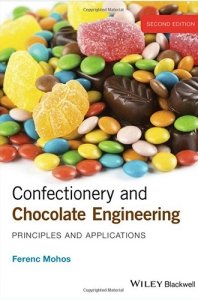Ref: CT015
EUR 240,-
excl. VAT + postage
Confectionery and Chocolate Engineering
by Ferenc Mohos
A. John Wiley & Sons Ltd
Publication date: August 2010
Hardcover, 712 pages
ISBN: 978-1-4051-9470-9
In contrast to the common technology-focused approach to this subject, this volume offers a scientific, theoretical account of confectionery manufacture, building on the scientific background of chemical engineering. It describes the features of unit operations used in confectionary manufacturing. The large diversity of both raw materials and end products in the confectionery industry makes it beneficial to approach the subject in this way. By characterizing the unit operations the author opens up new possibilities for improvement and efficiency for anyone involved in the production of confectionary worldwide.
Table of Contents
Part I Theoretical introduction.
Chapter 1 Principles of food engineering.
1.1 Introduction.
1.2 The Damköhler equations.
1.3 Investigation of the Damköhler equations by means of similarity theory.
1.4 Analogies.
1.5 Dimensional analysis.
1.6 The Buckingham theorem.
Chapter 2 Characterization of substances used in the confectionery industry.
2.1 Qualitative characterization of substances.
2.2 Quantitative characterization of confectionery products.
2.3 Preparation of recipes.
Chapter 3 Engineering properties of foods.
3.1 Introduction.
3.2 Density.
3.3 Fundamental functions of thermodynamics.
3.4 Latent heat and heat of reaction.
3.5 Thermal conductivity.
3.6 Thermal diffusivity and Prandtl number.
3.7 Mass diffusivity and Schmidt number.
3.8 Dielectric properties.
3.9 Electrical conductivity.
3.10 Infrared absorption properties.
3.11 Physical characteristics of food powders.
Chapter 4 The rheology of foods and sweets.
4.1 Rheology: its importance in the confectionery industry.
4.2 Stress and strain.
4.3 Solid behaviour.
4.4 Fluid behaviour.
4.5 Viscosity of solutions.
4.6 Viscosity of emulsions.
4.7 Viscosity of suspensions.
4.8 Rheological properties of gels.
4.9 Rheological properties of sweets.
4.10 Rheological properties of wheat fl our doughs.
Chapter 5 Introduction to food colloids.
5.1 The colloidal state.
5.2 Formation of colloids.
5.3 Properties of macromolecular colloids.
5.4 Properties of colloids of association.
5.5 Properties of interfaces.
5.6 Electrical properties of interfaces.
5.7 Theory of colloidal stability: the DLVO theory.
5.8 Stability and changes of colloids and coarse dispersions.
5.9 Emulsion instability.
5.10 Phase inversion.
5.11 Foams.
Part II Physical operations.
Chapter 6 Comminution.
6.1 Changes during size reduction.
6.2 Rittinger’s ’surface‘ theory.
6.3 Kick’s ‚volume‘ theory.
6.4 The third, or Bond, theory.
6.5 Energy requirement for comminution.
6.6 Particle size distribution of ground products.
6.7 Particle size distributions.
6.8 Kinetics of grinding.
6.9 Comminution by five-roll refiners.
6.10 Grinding by a melangeur.
6.11 Comminution by a stirred ball mill.
Chapter 7 Mixing/kneading.
7.1 Technical solutions to the problem of mixing.
7.2 Power characteristics of a stirrer.
7.3 Mixing-time characteristics of a stirrer.
7.4 Representative shear rate and viscosity for mixing.
7.5 Calculation of the Reynolds number for mixing.
7.6 Mixing of powders.
7.7 Mixing of fl uids of high viscosity.
7.8 Effect of impeller speed on heat and mass transfer.
7.9 Mixing by blade mixers.
7.10 Mixing rolls.
7.11 Mixing of two liquids.
Chapter 8 Solutions.
8.1 Preparation of aqueous solutions of carbohydrates.
8.2 Solubility of sucrose in water.
8.3 Aqueous solutions of sucrose and glucose syrup.
8.4 Aqueous sucrose solutions containing invert sugar.
8.5 Solubility of sucrose in the presence of starch syrup and invert sugar.
8.6 Rate of dissolution.
Chapter 9 Evaporation.
9.1 Theoretical background – Raoult’s law.
9.2 Boiling point of sucrose/water solutions at atmospheric pressure.
9.3 Application of a modifi cation of Raoult’s law to calculate the boiling point of carbohydrate/water solutions at decreased pressure.
9.4 Vapour pressure formulae for carbohydrate/water solutions.
9.5 Practical tests for controlling the boiling points of sucrose solutions.
9.6 Modelling of an industrial cooking process for chewy candy.
Chapter 10 Crystallization.
10.1 Introduction.
10.2 Crystallization from solution.
10.3 Crystallization from melts.
10.4 Crystal size distributions.
10.5 Batch crystallization.
10.6 Isothermal and non-isothermal recrystallization.
10.7 Methods for studying the supermolecular structure of fat melts.
10.8 Crystallization of glycerol esters: Polymorphism.
10.9 Crystallization of cocoa butter.
10.10 Crystallization of fat masses.
10.11 Crystallization of confectionery fats with a high trans-fat portion.
10.12 Modelling of chocolate cooling processes and tempering.
Chapter 11 Gelling, emulsifying, stabilizing and foam formation.
11.1 Hydrocolloids used in confectionery.
11.2 Agar.
11.3 Alginates.
11.4 Carrageenans.
11.5 Furcellaran.
11.6 Gum arabic.
11.7 Gum tragacanth.
11.8 Guaran gum.
11.9 Locust bean gum.
11.10 Pectin.
11.11 Starch.
11.12 Xanthan gum.
11.13 Gelatin.
11.14 Egg proteins.
11.15 Foam formation.
Chapter 12 Transport.
12.1 Types of transport.
12.2 Calculation of flow rate of non-Newtonian fluids.
12.3 Transporting dessert masses in long pipes.
12.4 Changes in pipe direction.
12.5 Laminar unsteady flow.
12.6 Transport of flour and sugar by air flow.
Chapter 13 Pressing.
13.1 Applications of pressing in the confectionery industry.
13.2 Theory of pressing.
13.3 Cocoa liquor pressing.
Chapter 14 Extrusion.
14.1 Flow through a converging die.
14.2 Feeders used for shaping confectionery pastes.
14.3 Extrusion cooking.
14.4 Roller extrusion.
Chapter 15 Particle agglomeration: Instantization and tabletting.
15.1 Theoretical background.
15.2 Processes of agglomeration.
15.3 Granulation by fl uidization.
15.4 Tabletting.
Part III Chemical and complex operations: Stability of sweets.
Chapter 16 Chemical operations (inversion and caramelization), ripening and complex operations.
16.1 Inversion.
16.2 Caramelization.
16.3 Alkalization of cocoa material.
16.4 Ripening.
16.5 Complex operations.
Chapter 17 Water activity, shelf life and storage.
17.1 Water activity.
17.2 Shelf life and storage.
17.3 Storage scheduling.
Chapter 18 Stability of food systems.
18.1 Common use of the concept of food stability.
18.2 Stability theories: types of stability.
18.3 Shelf life as a case of marginal stability.
18.4 Stability matrix of a food system.
Part IV Appendices.

